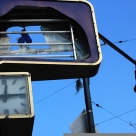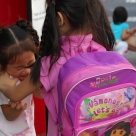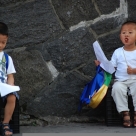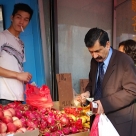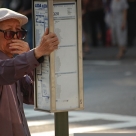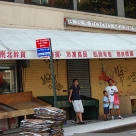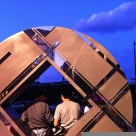- Art
- Barry Hannah
- Exploration
- Fiction
- Open City/AAWW
- Angela Narciso Torres
- Angie Mazakis
- Celina Su
- Cristiana Baik
- Deanna Fei & Jessica Fei
- Deepak Unnikrishnan
- Hai-Dang Phan
- Iris A. Law
- Kaveh Bassiri
- Kimberly Alidio
- Lawrence Dizon Sumulong
- Mark Anthony Cayanan
- Murli Melwani
- Peggy Lee
- Raj K Ramaswamy
- Rajiv Mohabir
- Rathanak Michael Keo
- Sahar Muradi & Zohra Saed
- W. Todd Kaneko
- Wah-Ming Chang
- Sound Art/Dissonance
- Speculative
- Trance Poetics
The Cross Currents of Flushing, Queens: A Photo Essay
Last fall, when I first set out to explore Flushing for the Asian American Writers’ Workshop’s new blog, Open City, I realized that the neighborhood most often cropped up in my own vocabulary as the place where I’m from, where I was born and raised, where I often go “back” to see my parents. [see photo 1] In other words, until then, Flushing had principally become the place of my past. Even the landmarks from my childhood that still stand seemed most vivid in my memories: the Chung Hwa bookstore, where I spent many bored hours with my grandmother; the Q26 bus stop, where a driver once referred to a line of us Asians as “another handful of macaroni”; Elite Academy, a cram school where I was sent to gain entry to a Manhattan school—and, by extension, a future—that was more, well, elite. [see photo 2]
[see photo 3] At the same time, from my current perch in gentrifying Brooklyn amid the chattering classes of foodies and bloggers, Flushing has become the buzzword of where-to-eat-now, the place name tossed off in knowing tones, along with references to knife-cut noodles and lamb offal, to mark the speaker as a kind of hip pioneer, the first in his milieu to venture past the Mets stadium and that swampy smell to the last stop on the 7. [see photo 4] It’s a place that’s being discovered, a new territory for those in the know, the destination of the near-future.
[see photo 5] Then, a few months ago, I picked up Ha Jin’s latest story collection, A Good Fall. For his characters, an often-invisible class of recent Chinese immigrants, Flushing is the place where they are constantly arriving, yet never truly arrive. [see photo 6] It’s the entrepreneurial launch pad to the American dream where most “didn’t bother to use English in everyday life… perhaps they were too desperate for survival to worry about that.” It’s a place whose inhabitants “didn’t plan to stay long… as if their current residences were merely a transitory step.” [see photo 7] It’s a neighborhood that leads one character’s visiting mother to marvel, after eating street kebabs and Shanghainese buns and purchasing mung bean noodles for only $1.20, “Now I believe it’s true that all China’s best stuff is in the U.S.” Meanwhile, another character notes, “I feel I’m still in the yuan system, even though I’ve lived and worked in the United States for more than two decades.” For this community, Flushing represents a bewildering suspension in space and time; a place where people might settle in, but not settle down; a never-quite-home. [see photo 8]
What’s undeniable about Flushing, whoever you are and whenever you go, is how it catches you up in its currents. [see photo 9] It is, most centrally, a place of transit, of exchange, of rushed comings and goings, of resigned waiting, of rare and fleeting moments of rest. For all that immigrant enclaves inspire contemplation of traditional versus modern, familiar versus foreign, past versus future, once you step onto the streets of Flushing, you know just where you stand: right here, right now. [see photo 10]
Deanna Fei is the author of A Thread of Sky: A Novel (Penguin), a New York Times Editors’ Choice and an Indie Next Notable Book, recently named a 2010 Best Book by the Chinese American Librarians’ Association. A graduate of Amherst College and the Iowa Writers’ Workshop, she is the recipient of a Fulbright Grant, a New York Foundation for the Arts fellowship, and a Chinese Cultural Scholarship. Her essays have appeared in the Huffington Post, New York Times, and The Millions. For more information, visit http://deannafei.com.
Jessica Fei is a photographer, educator, and teaching artist from Queens, New York. With a B.A. in Literature and Ethnicity, Race, & Migration from Yale University, Jessica has completed documentary photography projects in Cuba, Mexico, and China. Her work has appeared in the New York Times Lens Blog, The Printed Blog, and Open City, and been exhibited in galleries in New Haven and New York City. For more on Jessica, please visit www.jessicafei.com.

